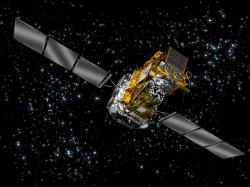Years of work are about to pay off, as Europe’s Large Hadron Collider is almost ready to come online. Soon physicists will be awash in data from the highly energetic particle collisions generated in the facility. But Nature, as usual, already has the upper hand, with a natural particle accelerator capable of pushing particles with 20 times as much energy as the LHC.
ESA’s Integral gamma ray observatory has been watching one of the brightest X-ray regions in the sky, known as the Ophiuchus galaxy cluster. And it’s turned up evidence that the violent region is acting like a natural particle accelerator, pushing electrons to enormous energies.
What kind of environment could create this?
You think the Sun is hot, clocking at a few thousand degrees Kelvin. But the gas in Ophiuchus is more than 100 million degrees Kelvin. Ophiuchus actually contains two galaxies clusters in the process of merging. The violence of this merger sends intense shockwaves rippling through the superheated gas.
The researchers are considering two specific mechanisms for how these X-rays are produced, and are planning follow-up observations to understand it better. In one situation, electrons are caught in the magnetic field threading through the cluster. As they spiral around, they would release the X-ray radiation. In a second scenario, the electrons would actually carry 100,000 times as much energy, and might be colliding with the background microwave radiation in the Universe, left over from the Big Bang.
It’s this X-ray radiation that Integral spotted.
Ophiuchus is able to give particles 20 times as much energy as researcher are hoping to coax out of the Large Hadron Collider.
“Of course the Ophiuchus cluster is somewhat bigger,” says Stéphane Paltani, a member of the team. While LHC is 27 km across, the Ophiuchus galaxy cluster is over two million light-years in diameter.”
Original Source: ESA News Release


20 times the energy but a ‘size’ reduction from two million light years to 27km – The LHC still sounds impressive to me..
Just one more example of how gloriously experimentation, observation and theory work together to help us come to a glimmer of understanding of this mysterious universe. It really is a beautiful thing…
Even at my old age, I’m still fascinated with the discoveries in astronomy and physics. I wish I understood them better–but even we less than bright folks can take a great interest in the wonders of the Universe.
And so it goes on. Each large technical step forward reveals new discoveries that will reshape, not confirm, how we think about matter, space, time, other dimesnsions/universes whatever…. My question is still the same: When/how will we know when we smash the last particle that we have finally gotten to the undivisible mother-of-all particles — what I call the ‘God particle’?
could do better.
Thank you,
I just really hope the Boyz and Girls at C.E.R.N
know what they are doing. If they crack a particle too much, do they really know what they are playing with…….? Let’s hope caution is their middle name…..NUFF said
Scottie 5000
Luckily never…He will always be a human creation and just a figment of your imagination.
Dwight, we will never find the smallest particle because it doesn’t exist. God designed it that way. As for Kevin, I feel very sorry for you. Just as we haven’t seen the smallest particle, we can see their evidences, the same way we see God’s evidences. Look up some clear night and take a look at His spectacular creation.
Thanks, Clint. Some scientists are more interested in projecting their personal ideologies than honestly observing the universe, which always infintely exceeds our grasp. A different Kevin.
when i can design and create a galaxy,then i might complain until then i will just enjoy!the human race cannot create or duplicate something that is not ours.how much energy do we really NEED.what do you think will happen when our galaxy joins our nearest neighbor,it’s going to happen.hopefully earth will catch the tail.my FATHER knows what HE is doing and i am grateful for this free gift of beauty.
It is not unusual to find that our latest discoveries are dwarfed by events in nature.
Enrico Fermi received credit for the World’s first self-sustaining chain of fission reactions in a WWII experiment beneath the University of Chicago’s Stagg Field on Dec 2, 1942.
Fourteen years later, Paul K. Kuroda predicted that a series of self-sustaining fission reactions had occurred in the early Earth when the U-235/U-238 ratio was much higher than it is today [J. Chem. Physics 25 (1956) 781-782; ibid. 1295-1296]
Another sixteen years passed before Francis Perrin and the French Atomic Energy Commission (Commissariat à l’énergie atomique) reported that a series of self-sustaining fission reactions had occurred about 1.5 billion years ago in the uranium deposit at the Oklo Mine in Gabon.
Wikipedia reviews these discoveries:
http://en.wikipedia.org/wiki/Natural_nuclear_fission_reactor
With kind regards,
Oliver
Clint, et, al. We see as much evidence of God as we do UFO’s, and we can’t prove either one exists or doesn’t exist. 😉
Actually we have more physical evidence of UFO’s. I haven’t seen a photo of God yet. And absolutely not a HE, if there even is one. Would have to be a SHE.